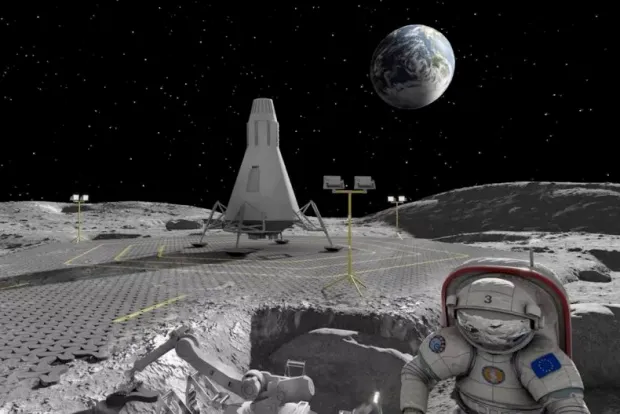Illumination and a substantial lens might facilitate lunar road construction.
Rejoice, those of us who have ever used a magnifying glass to start fires, for it turns out that we were unknowingly engaging in the same scientific principles that could be applied to construct roads, launch pads, and more on the Moon.
A recent publication in Scientific Reports presents an ambitious method to transform the lunar surface into usable materials. The paper proposes that all we need is a 7.8-foot (2.37 meters) Fresnel lens. These lenses, characterized by concentric circles of glass on their surfaces, possess exceptional light-focusing capabilities while requiring less material. This makes them an ideal choice for lunar missions, where space and weight are valuable resources.
Specifically, the study reveals that utilizing a Fresnel lens in conjunction with a laser to fuse lunar regolith would significantly reduce the power requirements (and consequently the size, weight, etc.) of the laser that astronauts would need to carry. Lead author Juan Carlos Ginés Palomares from Aalen University in Germany asserts that this approach is the optimal choice “due to its simple design and lightweight nature, in comparison to other regolith heating methods such as microwave ovens or electric ovens.”
Turning lunar rock usable
Ginés Palomares and his colleagues have conducted an experiment to determine the effectiveness of their method. They utilized a sample of material called EAC-1A, which was created by the European Space Agency to imitate lunar regolith. This sample was placed in a graphite crucible, known for its high temperature resistance of up to 5,000 degrees Fahrenheit (2,760 degrees Celsius), and a vacuum pump was used to replicate the Moon’s virtually non-existent atmosphere. To melt the simulated lunar regolith, they employed a laser with a beam that spreads out across a diameter of 3.74 inches (95 millimeters).
According to Ginés Palomares, their initial attempts to construct large components encountered difficulties. He states, “The first significant discovery was the ability to manufacture parts with a considerable thickness (up to 25 mm [1 inch]) using a single beam pass. However, we were disappointed to find that the parts broke or sustained damage when multiple overlapping paths were created.”
However, a breakthrough occurred when they successfully devised three-sided shapes (resembling an inwardly bent triangle) with a thickness of approximately 0.6 inch (15 mm). These shapes presented a potential solution to the problem as they could be interlocked to effectively cover a significant portion of the lunar surface.
After considering numerous configurations, the team ultimately determined that the Fresnel lens-laser combination was the most optimal choice for employment on the Moon.
Building materials everywhere
According to Ginés Palomares, this process offers remarkable advantages. One of the key advantages is the utilization of virtually unlimited resources such as sunlight and Moon dust. This is particularly significant considering the challenges of transporting building materials to the Moon and the issues caused by Moon dust. The ability to utilize existing resources with a convenient transportation setup could have a transformative impact on future lunar projects.
Phillip Metzger, a planetary physicist at the University of Central Florida and Kennedy Space Center’s Skunkworks, who was not involved in the study, focuses on utilizing planetary surface resources for material construction. He views this work as a crucial step in the right direction.
Metzger acknowledges the identification of several challenging phenomena by the authors. These include the formation of a three-layer material consisting of a glass top layer, a synthetic rock middle layer, and a thin sintered bottom layer. The incomplete melting in the bottom layer could potentially impact the integrity of construction materials. Metzger suggests that future studies should concentrate on controlling these phenomena.
Ginés Palomares also agrees that further testing of the material is necessary. For instance, subjecting it to conditions similar to rocket thrust to assess its durability as a launch pad. Additionally, testing its production under low-gravity conditions, such as a parabolic flight, to evaluate its performance in realistic lunar gravity conditions. Palomares emphasizes the need to study the formation of a large pool of molten material under lunar gravity, as low gravity tends to shape the pool into a spherical form due to the dominance of surface tension forces over gravity. This may require adjustments to the setup or the process to facilitate the production of flattened pieces.
Nevertheless, although the technology still has a few steps to take before it can begin paving the first lunar streets, it has made a promising start.
This article is republished from astronomy.com under a Creative Commons license. Read the original article.
Do not forget to share your opinion with us to provide you with the best posts !




0 Comments